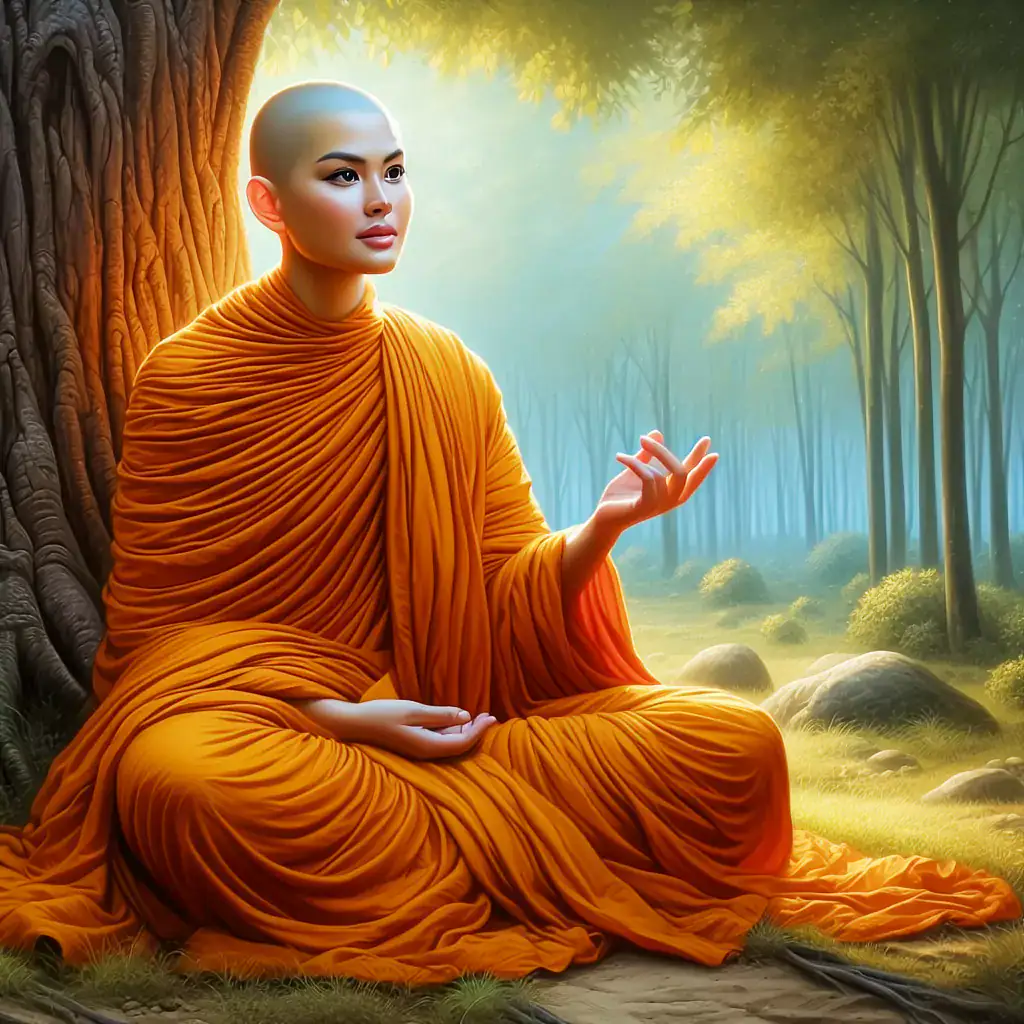Arahant Bhikkhuni Bhadda Kundalakesa
(Kundalakesa the Debating Ascertic)
In Rājagaha, the capital of the kingdom of Magadha, there lived a girl of good family named Bhaddā, the only daughter of a rich merchant. Her parents kept her confined to the top floor of a seven-story mansion, for she had a passionate nature and they were afraid that her awakening sexuality would lead her into trouble. One day Bhaddā heard a commotion down below in the street, and when she looked out the window she saw a criminal being led to the place of execution. He was a young man of station who had become a thief and was caught committing a robbery. As soon as Bhaddā set eyes upon him, love arose in her heart, and she lay down on her bed, refusing to eat unless she could have him for her husband. Her parents tried to dissuade her from such folly, but she would see no alternative. Thus her rich father sent a generous bribe to the guard and asked him to bring the man to his mansion.
The guard did as he was instructed, substituting a local derelict for the robber. The merchant gave the robber to his daughter in marriage, hopeful that his character might alter through this sudden change of fortune. Soon after the wedding, however, the bridegroom became obsessed with a desire to take possession of his wife’s jewellery. Thus he told her that while he was being led to the execution block he had vowed that if he could escape death, he would make an offering to a certain mountain deity. He urged Bhaddā to put on all her finest ornaments and accompany him to this deity’s haunt, a cliff off the top of a steep mountain. When they came to the cliff, called Robbers’ Precipice because it was here that the king would have criminals thrown to their death, her husband demanded that Bhaddā hand over all her jewellery to him. Bhaddā saw only one way to escape this predicament. She asked her husband permission to pay final obeisance to him, and as she embraced him, she threw him over the cliff, to be dashed to pieces down below.

-
Save
Burdened by the enormity of her deed, Bhaddā had no desire to return to lay life, for sensual pleasures and possessions no longer had any meaning for her. Therefore she decided to become a wandering ascetic. First she entered the order of the Jains, and as a special penance her hair was torn out by the roots when she ordained. But it grew again and became very curly, for which reason she was called Kuṇḍalakesā, which means “Curly-hair.”
The teaching of the Jain sect did not satisfy her, so she became a solitary wanderer. Travelling through India, she visited many spiritual teachers, learned their doctrines, and thereby obtained an excellent knowledge of religious texts and philosophies. She became especially skilled in the art of debate and in a short time became one of the most famous debaters in India. Whenever she entered a town, she would make a sand-pile and stick a rose-apple branch into it, announcing that whoever would engage in debate with her should notify her by trampling upon the sand-pile.
One day she came to Sāvatthī and again erected her little monument. At that time the Venerable Sāriputta was staying at the Jetavana monastery. He heard of the arrival of Bhaddā and, as a sign of his willingness for debate, he told several children to go and trample on the sand-pile. Thereupon Bhaddā went to Jetavana, confident of victory, accompanied by a large number of people.
She put a number of questions to Sāriputta, and he answered them all until she had nothing more to ask. Then Sāriputta questioned her. Already the first question affected Bhaddā profoundly, namely, “What is the one?” She remained silent, unable to determine what the elder could have intended. Surely, she pondered, he did not mean “God,” or “Brahman,” or “the Infinite.” But what was it then? The answer should have been “nutriment,” because all beings are sustained by food. Admitting defeat, Bhaddā asked Sāriputta for the answer, but he said that he would tell her only if she entered the Buddhist Order. The elder then sent her to the bhikkhunīs and had her ordained, and after a few days she attained arahantship.
Such is the version of Bhaddā’s meeting with the Dhamma that has been recorded in the Dhammapada Commentary, but Bhaddā’s verses in the Therīgāthā present a different picture:
Formerly I travelled in a single cloth
With plucked hair, covered with mud,
Imagining flaws in the flawless
And seeing no flaws in what is flawed.
Having come out from my daytime dwelling,
On the mountain Vulture’s Peak
I saw the spotless Enlightened One Accompanied by the Bhikkhu Sangha.
Then I humbly bowed down on my knees
And in his presence saluted him.
“Come, Bhaddā,” he said to me—
And that was my ordination.
(Thī 107–9)
In this version the meeting between Bhaddā and the Buddha takes place, not at Sāvatthī, but at Vulture’s Peak near Rājagaha, and Bhaddā receives ordination, not by the established procedure of a formal ceremony, but simply by the Buddha’s invitation to her to become a bhikkhunī. The discussion that took place between them is not recorded in the verses themselves, but Bhaddā must have attained realization very quickly; for the Buddha later declared her to be the foremost of the bhikkhunīs with respect to quickness of understanding (khippābhiññā). The Therīgāthā Commentary, in commenting on the verses, attempts to reconcile the verses and the old commentarial tradition. According to this version, after Bhaddā admitted defeat to Sāriputta, she paid homage to him and he brought her into the presence of the Buddha. Then the Teacher, aware that her wisdom was ripe, spoke to her a verse of the Dhammapada:
Though one hears a thousand verses
Made of lines devoid of meaning,
Better is a single meaningful line
By hearing which one is set at peace.
(Dhp 101)
At the conclusion of the verse she attained arahantship together with the analytical knowledges (paṭisambhidā–ñāṇa). Thereupon she requested the going forth. The Buddha consented to this and sent her to the order of nuns, where she received formal ordination.

-
Save
The Apadāna offers still another perspective on Bhaddā’s awakening. After Bhaddā had gone forth as a Jain nun she studied that philosophical system. One day, while she was sitting alone reflecting on that doctrine, a dog approached her with a mutilated human hand in its mouth, which it deposited right in front of her. When Bhaddā saw this, and noticed that the hand was crawling with worms, she received a deep spiritual shock. In a state of excitement she asked who could explain to her the significance of that incident. Her inquiries led her to the Buddhist monks, who brought her to the Master:
He then taught me the Dhamma,
The aggregates, sense bases, and elements,
The Leader told me about foulness,
Impermanence, suffering, and nonself,
Having heard the Dhamma from him,
I purified the vision of the Dhamma.
When I had understood true Dhamma,
(I asked for) the going forth and ordination.
Requested, the Leader then said to me, “Come, O Bhaddā!”
Then, having been fully ordained,
I observed a little streamlet of water.
Through that stream of foot-washing water
I knew the process of rise and fall.
Then I reflected that all formations
Are exactly the same in nature.
Right on the spot my mind was released,
Totally freed by the end of clinging.
The Victor then appointed me the chief
Of those with quick understanding.
(Ap II, 3:1, vv. 38–46)
The last couplet refers to the occasion when the Buddha declared Bhaddā the nun foremost in quickness of understanding (AN 1: chap. 14). This was a quality she shared with the monk Bāhiya, who reached arahantship in an instant when the Buddha told him: the seen there should be for you only the seen, in the heard only the heard, in the sensed only the sensed, in the cognised only the cognised” (Ud 1:10). Both had grasped the highest truth so quickly, and had penetrated it so deeply, that in a split-second they ascended from the stage of a worldling to arahantship.
Bhaddā’s later life was spent travelling over the North Indian countryside, preaching the Dhamma and guiding others to the same goal of deliverance that she herself had reached:
Free from defilements, for fifty years
I travelled in Aṅga and Magadha.
Among the Vajjis, in Kāsi and Kosala,
I ate the alms-food of the land.
That lay-supporter—wise man indeed—
Who gave a robe to Bhaddā,
Has generated abundant merit,
For she is one free of all ties.
(From the book: GREAT DISCIPLES OF THE BUDDHA – NYANAPONIKA THERA AND HELMUTH HECKER , Edited with an Introduction by BHIKKHU BODHI)
